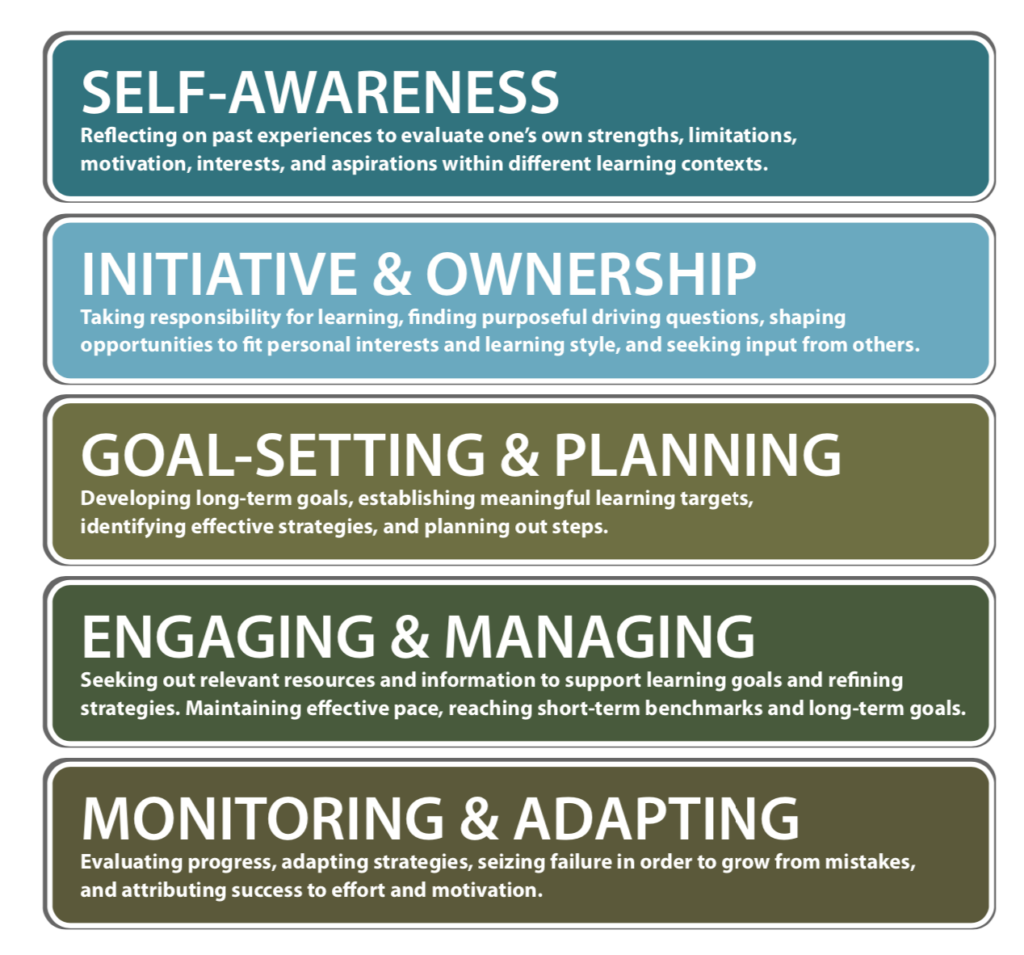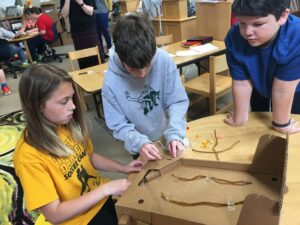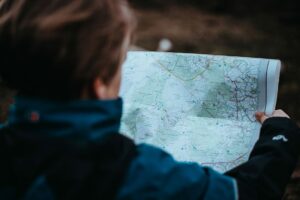When states around the country shifted towards standards-based, competency-based and proficiency-based learning and reporting, that involved separating the content-specific skills and knowledge from the learner-specific habits and behaviors.
The particular set of learner habits and behaviors that districts and states chose to measure and report have varied. Similarly, some states adopted guiding structures such as the Essential Skills and Dispositions framework created in 2015. In Vermont, the AOE created a set of proficiencies called the Transferable Skills. These two frameworks differ in some ways, but both have in common a focus on self-direction for students.
(The 5 Components of Self-Direction from the Essential Skills and Dispositions framework)

A little Vermont context
The first time that I saw the Vermont Transferable Skills was in 2015. Many of the skills, such as Clear and Effective Communication, seemed, well, clear. But over the years I have been increasingly puzzled by the definition and conceptual framework behind learner self-direction.

Nearly every mission and vision statement coming out of schools these days aspires to produce self-directed learners. This has me insatiably curious. What is self-direction? What does it mean to be a self-directed learner? From where? And why did this skill suddenly appear in our vocabulary? That is to say, I feel a burning desire to better understand the concept. For the sake of teaching and learning young people.
Turns out, self-direction and self-directed learning are terribly complex concepts
Self-direction is a human trait that combines psychological, educational, emotional, and social behavior. Behind self-direction is the messy interaction of those needs and behaviors. Self-direction manifests into outcomes of our human behavior and decision-making. Instinctually, educators want to frame self-direction as purely positive and compliance-oriented behaviors. But that is a myth.
Any action, human decision and behavior is an act of self-direction: “good” and “bad”. If I’m in my evening class and I’m bored and feel like I need to move my body, I might get up and leave class to go to the bathroom. That is an act of self-direction.

Consequently, the instructor might think that I made a poor choice to leave class and miss the information and learning. But I examined myself and made the decision. I directed my “self” based on my needs, motivations, my context, and my previous experiences.
Similarly to self-direction, self-directed learning has become an umbrella term in education. It refers to a host of processes and outcomes. In short, it’s an educational experience (formal or informal) where the learner has some knowledge of their personal needs, sets goals, makes decisions, and finds the necessary resources. Then the learner conducts the actions necessary to meet their learning needs and goals. The concept of self-directed learning is being increasingly applied to K-12 educational settings. What’s interesting is that the roots of self-directed learning are in adult education.
Some salient self-directed literature
Certainly, one of the most influential texts is Malcolm S. Knowles’ 1975 book, Self-Directed Learning: A Guide for Learners and Teachers. He was a leading authority in the field of adult education. He defines self-directed learning as,
“A process in which individuals take initiative, with or without the help of others, in diagnosing their learning needs, formulating learning goals, identifying human and material resources for learning, choosing and implementing appropriate learning strategies, and evaluating learning outcomes”
Another adult learning researcher, D. Randy Garrison, contributed to development of the self-directed learning concept. In 1991, he published Self-Directed Learning: Towards a Comprehensive Model and created this visual to show the interaction of four dimensions of self-directed Learning.
Checking assumptions
In each of these adult learning models, there is an implicit assumption that the learner has some control and responsibility over their learning. These two models rely on opportunities for the learner to direct their own learning and determine learning goals. More current frameworks of self-directed learning, like the ES & D, also require that the learner has the opportunity and occasion to own and manage their learning.
Alas, I would argue that in many K-12 educational settings, learners do not regularly have these opportunities and this control. Which suggests an interesting problem. What are the behaviors that we are teaching and assessing when students do not have the opportunity to be self-directed learners?
Finally, we (as educators) need to ask ourselves:
If the origins of self-directed learning are rooted in adult education, how do we adjust frameworks and expectations when we apply it to children and adolescents?
- What is a young person’s capacity and ability for self-direction and self-directed learning?
- What does self-direction look like in a 6 year old? In a 12 year old? In a 16 year old?
- How do our schools promote self-direction?
- What structures in our schools impede self-directed learning?
These are questions that need answers. I’d love to hear your thoughts and ideas.




You pose some great questions here about how exactly to define self-directed learning. I absolutely agree that it needs a clearer definition. One question I have for you is: “like the ES & D”. What’s ES & D in this context?
Great question! Apologies for the lack of clarity. I abbreviate and call the aforementioned Essential Skills and Dispositions framework as ES & D. I should make that more clear!
Oh that makes so much sense, thank you. I’d love to hear how you see this self-direction playing out in Vermont classrooms, but this reading list is also a fascinating place to dig in. Thank you!